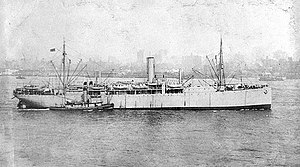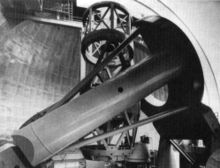SS Pennsylvanian
 SS Pennsylvanian, seen here as USS Scranton (ID-3511) in 1919
| |
| History | |
|---|---|
| Name | SS Pennsylvanian |
| Owner | American-Hawaiian Steamship Company |
| Port of registry | |
| Ordered | September 1911[4] |
| Builder |
|
| Cost | $715,000[5] |
| Yard number | 127[2] |
| Launched | 29 March 1913[3] |
| Completed | June 1913[2] |
| Identification | |
| Fate | Expropriated by U.S. Navy |
| History | |
| Name | USS Pennsylvanian (ID-3511)[6] |
| Acquired | 13 September 1918 |
| Commissioned | 13 September 1918 |
| Renamed | USS Scranton (ID-3511), November 1918[6] |
| Namesake | Scranton, Pennsylvania[7] |
| Decommissioned | 16 July 1919 |
| Fate | Returned to American-Hawaiian Steamship Co., 16 July 1919 |
| History | |
| Name | SS Pennsylvanian |
| Owner | American-Hawaiian Steamship Company |
| Port of registry | |
| Identification | |
| Fate | Expropriated by U.S. Navy; sunk as part of Mulberry Harbor off Normandy , 16 July 1944 |
| General characteristics | |
| Type | Cargo ship |
| Tonnage | 6,547 GRT[5] 10,175 LT DWT[5] 4,068 NRT[1] |
| Length | |
| Beam | 53 ft 6 in (16.31 m)[7] |
| Draft | 29 ft 6 in (8.99 m)[7] |
| Propulsion |
|
| Speed | 15 knots (28 km/h)[7] |
| Capacity | 491,084 cubic feet (13,906.0 m3)[5] |
| Notes | Sister ships: Minnesotan, Dakotan, Montanan, Panaman, Washingtonian, Iowan, Ohioan[2] |
| General characteristics (as USS Scranton) | |
| Displacement | 6,655 long tons (6,762 t)[7] |
| Troops | 1,840[10] |
| Complement | 94[7] |
| Armament | 7 × .50 cal (12.7 mm) machine guns[7] |
SS Pennsylvanian was a cargo ship built in 1913 for the American-Hawaiian Steamship Company. During World War I she was requisitioned by the United States Navy and commissioned as USS Pennsylvanian (ID-3511) in September 1918, and renamed two months later to USS Scranton. After her naval service, her original name of Pennsylvanian was restored.
Pennsylvanian was built by the
After her naval service ended in 1919, she was returned to her original owners and resumed relatively uneventful cargo service over the next twenty years. Early in World War II, the ship was requisitioned by the
Design and construction
In September 1911, the
Pennsylvanian (Maryland Steel yard no. 127)
Early career
When Pennsylvanian began sailing for American-Hawaiian, the company shipped cargo from
After the
Pennsylvanian's exact movements during 1916 and 1917 are unclear. She may have been in the half of the American-Hawaiian fleet that was
On 13 September 1918, Pennsylvanian was transferred to the U.S. Navy at New York and

Arriving at New York on 15 November, four days after the
On 5 February, Scranton was transferred from the NOTS to the Navy's

After repairs, Scranton made three roundtrips to France and carried some 6,000 troops and passengers home to the United States before she was decommissioned on 19 July. The ship was handed over to the USSB for return to American-Hawaiian, who restored her original name.[7]
Interwar years
Pennsylvanian resumed cargo service with American-Hawaiian after her return from World War I service. Though the company had abandoned its original Hawaiian sugar routes by this time,
Other hints of Pennsylvanian's activities throughout the rest of her career can be found from contemporary newspaper reports. In October 1929, the Los Angeles Times reported on a shipment that included 2,500 to 3,000 radio sets among Pennsylvanian's 2,300 long tons (2,340 t) of cargo.[27] In March 1938, The Christian Science Monitor reported that Pennsylvanian's captain, C. M. Bamforth, had temporarily turned the deck of the cargo ship into a boatyard to build a 15-foot (4.6 m) catboat for his son in Swampscott, Massachusetts. Bamforth laid the keel while in San Francisco, bought copper rivets for the hull planking in Portland, Oregon, and began painting the boat after Pennsylvanian had traversed the Panama Canal. He expected to have the boat finished when Pennsylvanian arrived in Boston on 22 April.[28]

In October the same year, Pennsylvanian delivered 325 long tons (330 t) of steel parts for the Hale Telescope then under construction at the Palomar Observatory outside San Diego. The ship had picked up the $375,000 cargo in Philadelphia before sailing for San Diego.[29]
World War II
At some point after the United States entered World War II, Pennsylvanian was requisitioned by the
Between May and September 1943, Pennsylvanian made four transatlantic crossings between New York and
In March 1945, the WSA offered a payment of $565,910 to American-Hawaiian for Pennsylvanian as part of a $7.2 million settlement for eleven requisitioned American-Hawaiian ships that had either been sunk, scuttled, or were to be retained by the government.[30]
Notes
- ^ Maryland Steel had built three ships—Kentuckian, Georgian, and Honolulan—for American-Hawaiian in 1909 in what proved to be a satisfactory arrangement for both companies.
- ^ Further contracts on similar terms were signed in November 1911 and May 1912 to build four additional ships: Panaman, Washingtonian, Iowan, Ohioan. See: Cochran and Ginger, p. 358, and Colton.
- ^ Though the canal transit was part of an eastbound journey, the actual compass heading of the passage through the canal is actually closer to north.
- ^ The Luckenbach Line ship Pleiades was the other steamship to make the eastbound transit of the canal at the same time. Contemporary sources refer to the pair as the first two, making no distinction between which was first. See: Barrett, John (20 August 1914). "Greet first canal ships" (PDF). The New York Times. p. 7. Retrieved 12 August 2008. Also see: "All astounded by war news". Los Angeles Times. 15 August 1914. p. II– 8.
- Seine Bayon 20 July.
References
- ^ a b c d e f g "LLOYD'S REGISTER, STEAMERS & MOTORSHIPS" (PDF). Plimsoll Ship Register. Archived from the original (PDF) on 2015-10-05. Retrieved 29 March 2014.
- ^ a b c d e Colton, Tim. "Bethlehem Steel Company, Sparrows Point MD". Shipbuildinghistory.com. The Colton Company. Archived from the original on 8 October 2008. Retrieved 12 August 2008.
- ^ a b c d "Pennsylvanian (2211297)". Miramar Ship Index. Retrieved 15 April 2009.
- ^ a b Cochran and Ginger, p. 358.
- ^ a b c d e f Cochran and Ginger, p. 365.
- ^ Naval History & Heritage Command. 2 May 2007. Archived from the originalon 27 September 2008. Retrieved 16 April 2009.
- ^ a b c d e f g h i j k l m n o Navy Department, Naval History & Heritage Command. "Scranton". DANFS. Retrieved 12 August 2008.
- ^ "LLOYD'S REGISTER, NAVIRES A VAPEUR ET A MOTEURS" (PDF). Plimsoll Ship Register. Archived from the original (PDF) on 2015-10-05. Retrieved 29 March 2014.
- ^ a b c Cochran and Ginger, p. 357.
- ^ Crowell and Wilson, p. 572.
- ^ Hovey, p. 78.
- ^ Cochran and Ginger, p. 355–56.
- ^ "American-Hawaiian Steamship Co". Los Angeles Times (display ad). 13 April 1914. p. I–4.
- ^ "American-Hawaiian new steamships". The Wall Street Journal. 6 May 1912. p. 6.
- ^ a b Barrett, John (20 August 1914). "Greet first canal ships" (PDF). The New York Times. p. 7. Retrieved 12 August 2008.
- ^ a b Cochran and Ginger, p. 360.
- ^ "Pacific-Boston sailings begun". The Christian Science Monitor. 29 August 1914. p. 19.
- ^ Cochran and Ginger, p. 361.
- ^ Cochran and Ginger, p. 362.
- ^ a b Cochran and Ginger, p. 363.
- ^ The Atlanta Constitution. 30 March 1919. p. 2.
- ^ a b Navy Department, Naval History & Heritage Command. "El Sol". DANFS. Retrieved 12 August 2008.
- Naval Historical Center. 5 July 2004. Archived from the originalon 11 September 2007. Retrieved 12 August 2008.
- ^ a b c "82 Nurses return; served under fire". The Washington Post. 4 April 1919. p. 5.
- ^ Naval Historical Center. Archived from the originalon 28 September 2008. Retrieved 12 August 2008.
- ^ "Fog causes two ferry smash-ups". Los Angeles Times. 29 November 1930. p. 1.
- ^ Cave, Wayne B. (7 October 1929). "Shipping News and Activities at Los Angeles Harbor". Los Angeles Times (column). p. 13.
- ^ "Boat built aboard ship; B. & M. reports for 1937". The Christian Science Monitor. 28 March 1938. p. 9.
- ^ "Mt. Palomar Observatory's steel parts taken off ship". Los Angeles Times. 26 October 1938. p. 9.
- ^ a b Stone, Leon (31 March 1945). "U.S. awards $7,247,637 to Hawaiian ship firm". The Christian Science Monitor. p. 4.
- ^ a b "Port Arrivals/Departures: Pennsylvanian". Arnold Hague's Ports Database. Convoy Web. Retrieved 12 August 2008.
Bibliography
- OCLC 216113867.
- OCLC 18696066.
- Hovey, Edmund Otis (1907). "The Isthmus of Tehuantepec and the Tehuantepec National Railway". Bulletin of the American Geographical Society. 39 (2). New York: OCLC 2097765.
- Naval History & Heritage Command. "El Sol". Dictionary of American Naval Fighting Ships. Navy Department, Naval History and Heritage Command. Retrieved 12 August 2008.
- Naval History & Heritage Command. "Scranton". Dictionary of American Naval Fighting Ships. Navy Department, Naval History & Heritage Command. Retrieved 12 August 2008.
- Naval History & Heritage Command (11 July 2004). "USS Scranton (ID # 3511) Photo Album, 1919". Online Library of Selected Images: Photo Albums. Navy Department, Naval Historical Center. Archived from the original on 28 September 2008. Retrieved 2008-08-12.
External links
- Photo gallery of Scranton (ID-3511) at NavSource Naval History
49°22′29″N 0°53′31″W / 49.37472°N 0.89194°W
